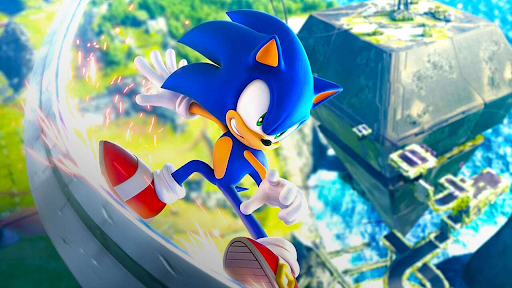Sonic Frontiers: Game Review

Sonic Frontiers was supposed to release in 2021, but it was delayed to 2022 in order to improve its quality. After the two “Sonic the Hedgehog” movie adaptations did well at the box office and received generally positive feedback, it makes sense that SEGA would like the next big “Sonic” game to exceed commercial and critical expectations, too. Sonic Frontiers is a crockpot of a bunch of different game mechanics and depicts an open-world concept.
Story Structure
The game starts off with a brief introduction to our heroes, Sonic, Tails, and Amy. After some digital hocus pocus, Sonic mysteriously falls through a wormhole and crash-lands on the Starfall Islands, one of the game’s ‘Cyberspace’ levels, which is based on Green Hill Zone.
This linear stage acts as a tutorial for Sonic’s basic move-set, but you’ll be able to revisit it later on to complete the optional objectives and gain extra items if you so wish.
Separated from his friends, Sonic must reunite with them by visiting all five of the islands while also unravelling the mystery surrounding the area’s ancient civilization. It turns out that Sonic’s friends are missing, and it’s up to you to find and rescue them.
The plot for Frontiers is about as bonkers as you can reasonably expect from a 3D Sonic title, but the overall tone of the game has been toned down in comparison to the previous titles.
Having said that, it makes way for two-way conversations between Sonic and one of his buddies, with very little action in between to add some much-needed variety. The story ramps up nicely towards the end, however, and the game even makes some pretty satisfying callbacks to earlier titles in the franchise.
Gameplay
Sonic has to keep running around and collecting a variety of different items. The islands are littered with platforming challenges filled with rails and bumpers that Sonic can ride on that have rewards at the end, such as stat upgrades and tokens. Collecting a certain number of tokens is needed to unlock new cutscenes with characters that further the main story.
The game requires you to unlock the map bit by bit by completing minigames, opening up random sections that will eventually fill in to form a complete image. Although the islands aren’t overly big, it’s still possible to get a bit lost if you haven’t unlocked much of the map.
You will be dropped into the first of the five open-world islands, Kronos Island. Once you’re on Kronos Island, the game will brief you about the linear path and introduce various gameplay aspects like combat and the ‘Cyloop’ ability.
Cyloop effectively lets you run circles around objects and enemies, leaving behind a trail that, when reconnected to form a loop, will either deal damage, activate switches, or grant you a sizable dose of rings.
You can more or less cheat the game into giving you infinite numbers of rings by just running around in tiny circles at any point; each completed circle gives you about 15 or so rings, and there’s no limit to how many times you can do it. Eventually, you’re given free rein to go wherever you want. The sheer size of each island is genuinely quite impressive, though it’s not so large as to become overwhelming.
Combat Skills
Combat and skill progression feel like a natural addition to Sonic’s gameplay. Sonic learns 15 combat skills in this game, such as being able to shoot balls of light and counter-attacking when he gets hit.
The counterattack recovery is probably the last skill unlocked, and it’s staggering how much it elevates the flow of combat. By the time you reach the end and have thoroughly explored the different islands, you’ll have enough skill points to unlock all of Sonic’s abilities.
During boss fights, Sonic transforms into Super Sonic, where he’s immune to damage but your ring metre slowly decreases. If you don’t defeat the boss before your ring count hits zero, you have to play through the entire battle again.
Additionally, when you restart the fight, you start off with zero rings. Not only do you have to start over, but you’re also punished for losing, which feels unfair.
=
Controls
As for how Sonic controls, it’s a hit-and-miss. Running around the world feels exhilarating for the most part; Sonic will turn fairly accurately even at high speeds, and hitting ‘ZR’ will result in an immediate speed boost that feels immensely satisfying in practice. However, when the game expects you to complete any kind of precise platforming, the movement feels sluggish.
Trying to navigate certain routes can often feel off; you can try to course-correct by hitting ‘ZR’ to give yourself a bit of a boost, but the game will frequently overcompensate, sending you flying off into the abyss.
The slightest curve would send him tumbling all the way down, and you’d have to start over again. Glitches occur more often than we’d expect, sending Sonic tearing through platforms or getting caught up in the camera.
Surprisingly, most of the sections that require you to grind on rails or bounce between springboards are almost entirely automatic, as if the game’s aware of its own technical glitches. The game repeatedly takes control away from the player because it knows that if it gives the player complete control, the mechanics will fall apart.
Then again, this has been the case since Sonic entered the 3D realm with Sonic Adventure back in 1998. With this in mind, while you can absolutely go anywhere and do anything while exploring each of the five islands, it never quite feels like the sandbox elements reach their true potential because the game doggedly refuses to give you total control during its platforming segments.
Cyberspace
Sonic can enter Cyberspace through various portals scattered across the islands, which are short, linear levels similar to those found in previous Sonic games. They’re either presented in a third-person or side-scrolling perspective.
Completing different objectives, like finishing the level within a certain time limit, or collecting a set amount of rings, will earn you Vault Keys, which are required for the progression of the game’s story.
Gather up enough vault keys and then you’ll finally be able to collect a Chaos Emerald, which is one of the two main goals on each island. The other goal is to collect memory tokens to unlock story cutscenes with Sonic’s allies.
The Cyberspace levels are your more traditional, linear “2D” and “3D” Sonic stages and are accessed by locating portals dotted around each of the five islands. Although there are quite a few dotted about each island, they’re only based on four key themes: the Green Hill Zone, Chemical Plant, Sky Sanctuary, and a City theme.
The actual layouts of these stages have been lifted straight out of previous games; some might call this a loving homage to Sonic’s past, but we’re a bit baffled that Team Sonic didn’t make some original levels based on the theme.
Graphics
Sonic Frontiers is a not-so-visually appealing game. It’s pretty flashy and looks quite nice for the most part, but there’s an odd CRT filter applied, which we assume is to indicate that you’re in some sort of digital space. The frame rate is serviceably smooth and solid, with a 30 FPS target that it hits for the most part.
You’ll notice from the very moment that you set foot on Kronos Island that the game’s assets pop in and out all the time; we’re not just talking about small bits of foliage or rocks, either, but huge platforms, grind rails, enemies, and even entire cliff sides.
It’s a bit nauseating to run through the environment only to see everything jitter and warp around you as the game tries to keep up. The visuals just simply look incredibly grainy and muddy.
All in all, while there’s definitely potential for a good game to eventually arise from Sonic Frontiers’ bold shift into a semi-open world, this first attempt isn’t it.

